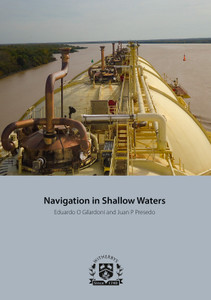
This book provides detailed explanations of ship squat and interaction, using worked examples, diagrams, case studies and the author’s personal computations and time-proven formulae.
Ship squat and interaction are major concerns for ship handlers, particularly when operating in shallow waters. This book examines the theory of these forces, how they compromise ship safety and the actions to take to avoid grounding or collision.
The first section of the book lists the signs that indicate when a ship has entered shallow water conditions. It describes methods of measuring squat and looks at the effect of speed on the squat value. Detailed guidance is provided on calculating squat and mean bodily sinkage, as well as the actions a ship can take to reduce squat. The guide provides 15 worked examples that guide the reader through each step of squat calculation.
The second section describes the causes and effect of interaction and identifies the situations in which it is likely to occur. It contains case studies that analyse the causes of various ship incidents related to interaction.
1.1 The Concept
Ship squat is the decrease in underkeel clearance as a ship moves forward after being static. Squat exists when a 3-D body (the ship) proceeds through a 3-D medium (the water). They are connected by a 3-D coefficient (the block coefficient or CB).
Throughout this book, the ratio of the water depth (H) to the ship’s static draught (T) at amidships is for a range of 1.10 to 1.40. Above an H/T of 1.40, there is much less risk of a vessel going aground. Because of the danger of grounding, very few measured squats for full-sized ships are recorded below H/T values of 1.10.
In rivers and canals, a ratio of cross-sectional area of the static ship’s midship section is related to the cross-sectional area of the river or canal. In this book, the ratio is only in the range of 0.100 to 0.250.
Chapter 1 – Introduction
1.1 The Concept
1.2 What Exactly is Ship Squat?
1.3 Who Should Know about Ship Squat and Interaction?
1.4 Ship Squat Measurements – Whereabouts in the World?
1.5 Ship-model Squat Measurements – Whereabouts in the World?
1.6 Why has Ship Squat Become so Important in the Last Forty Years?
Chapter 2 – Recent Incidents and Tell Tale Signs
2.1 Recent Ship Groundings and Sinkings
2.2 Static Underkeel Clearances
2.3 Dynamical Underkeel Clearances (y2)
2.4 United Kingdom Merchant Shipping Notices
2.5 Fifteen Signs that a Ship has Entered Shallow Water Conditions
Chapter 3 – Depth and Width of Influence of a Ship’s Path
3.1 Width of Influence
3.2 Depth of Influence
Chapter 4 – Effect of Speed
4.1 Ship’s Speed VK in a River having a Tidal Flow or Current
Chapter 5 – Measurement of Ship’s Squat
5.1 The Measurement of Ship Squat on Full-size Ships
5.2 Case Study 1 – Measurement of Squat at the Entrance to a Dock
5.3 Conclusions
Chapter 6 – Increase and Decrease of the Squat Value
6.1 What are the Factors Governing Ship Squat?
6.2 Silt Saucers and Dredging
6.3 Angles of Heel
6.4 Squat Formulae
6.5 Three Worked Examples
Chapter 7 – Squat Curves
7.1 Squat Curves
7.2 Squats Predicted for a Very Narrow River up to a Very Wide River
7.3 Asymptotic Squats
Chapter 8 – Squat when Trimmed and Steps to Reduce Squat
8.1 Ship Squat for Ships with Static Trim
8.2 Squats at Both Ends of a Vessel in Open Water
8.3 Worked Example
8.4 Procedures for Reducing Ship Squat
8.5 False Draughts
8.6 Ship Squat Laminates
Chapter 9 – Mean Bodily Sinkage
9.1 Mean Bodily Sinkage in Open Water Conditions
Chapter 10 – Using Squat to Assist in the Reduction of Air Draught
10.1 Introduction
10.2 General Particulars of ‘Freedom of the Seas’
10.3 Definition
10.4 Nomenclature
10.5 Prerequisite Information
10.6 Procedure
10.7 Formulae
10.8 Points to Consider Regarding Static Trim
10.9 Worked Example
10.10 Summary and Conclusions
Chapter 11 – Using Spreadsheets to Determine Squat
11.1 The All-encompassing Method
11.2 Case Study 2 – Cross Channel Ferry Squats in the Port of Newhaven
11.3 Case Study 3 – Squats in a Navigable Trench (Melbourne)
Chapter 12 – Incidents in Shallow Water
12.1 A Brief Introduction
12.2 Case Study 4
12.3 Squat Case Study 5
12.4 Squat Case Study 6
Chapter 13 – Calculated v Measured, How Accurate?
Chapter 14 – Final Summary and Conclusions
14.1 Nomenclature
14.2 Ship Squat Formulae
14.3 Merchant Ship Types – General Characteristics
14.4 Ships of this Millennium
14.5 Questions and Exercises on Ship Squat
14.6 Fifteen Worked Examples
Witherby Publishing Group Ltd
Witherbys titles are developed using scripts developed by technical experts that are peer reviewed within work groups. Typically, they seek to improve understanding of the regulations, recommendations and guidelines issued by Industry.
Witherbys staff have significant expertise in the fields of navigation and hazardous cargoes as well as in the presentation of complex subjects in a graphic and easy to understand manner.
Dr Bryan Barrass
Dr Bryan Barrass commenced his career as a Ship Draughtsman, working for 11 years at the Swan Hunter shipyard in Wallsend. In 1963, he became a Lecturer in Naval Architecture in Sunderland. From 1967 to 1993, he worked at Liverpool John Moores University, lecturing to maritime degree students, Masters, mates and marine engineers. He retired from full-time work in 1993 and became a visiting lecturer at universities in the UK, Singapore and Australia. His interest in ship squat began in April 1972, starting on research for his PhD, and he went on to author six books on ship stability, ship squat, ship design and ship performance.
- Number of Pages:
- 182
- ISBN:
- 9781905331604
- Book Height:
- 240 mm
- Book Width:
- 190 mm
- Weight:
- 0.8 kg
- Author:
Dr Bryan Barrass and Witherbys
- Published Date:
- September 2009
- Preview:
- Yes
- Publication Date:
- October 2019



